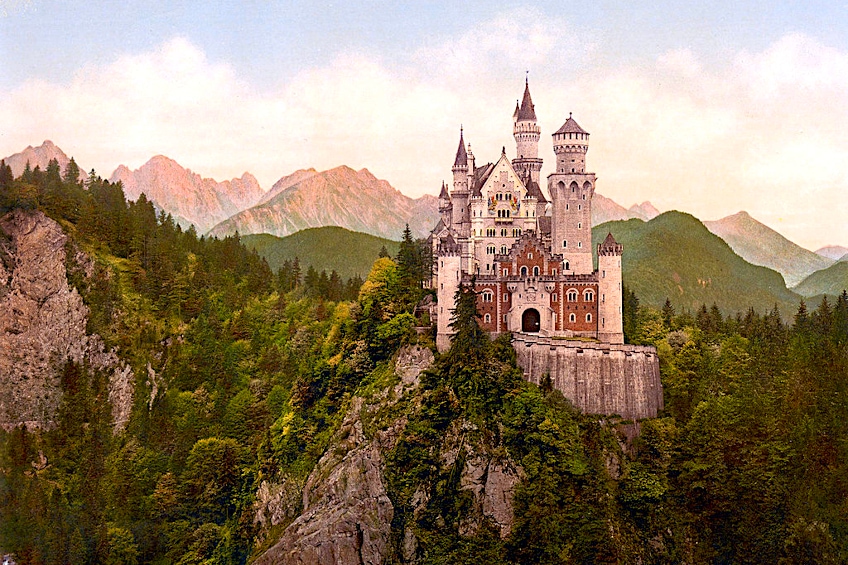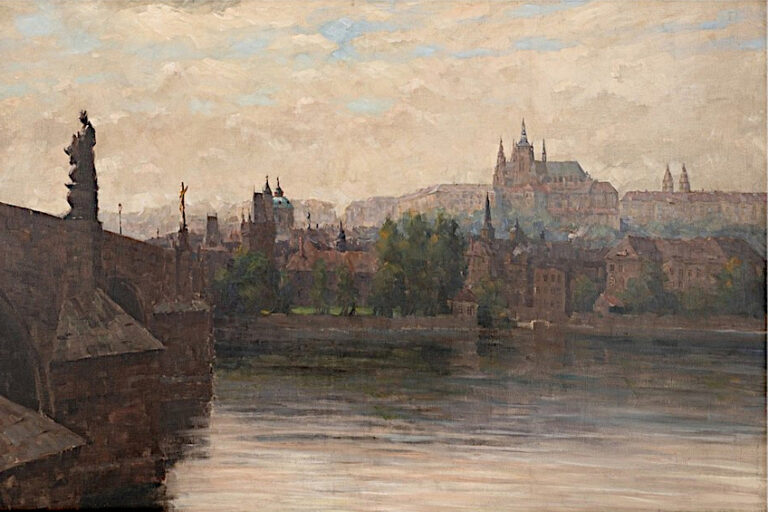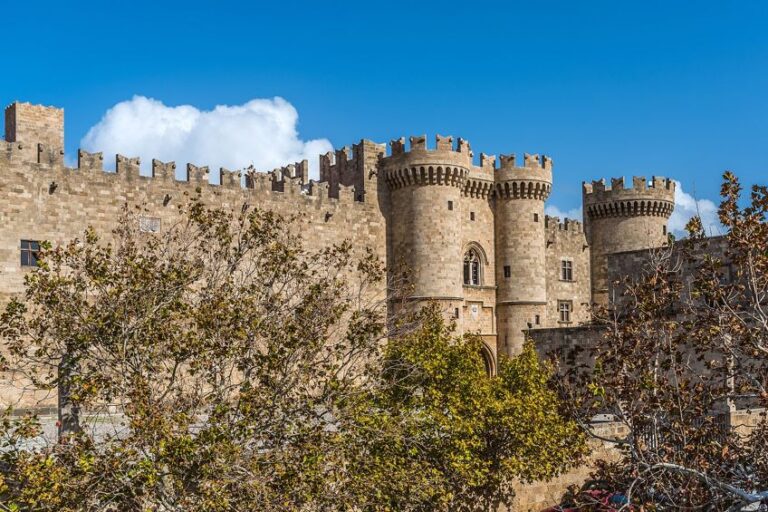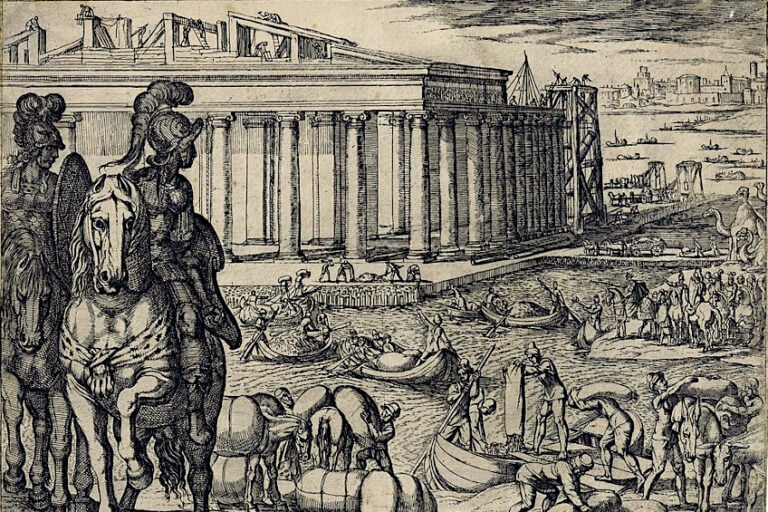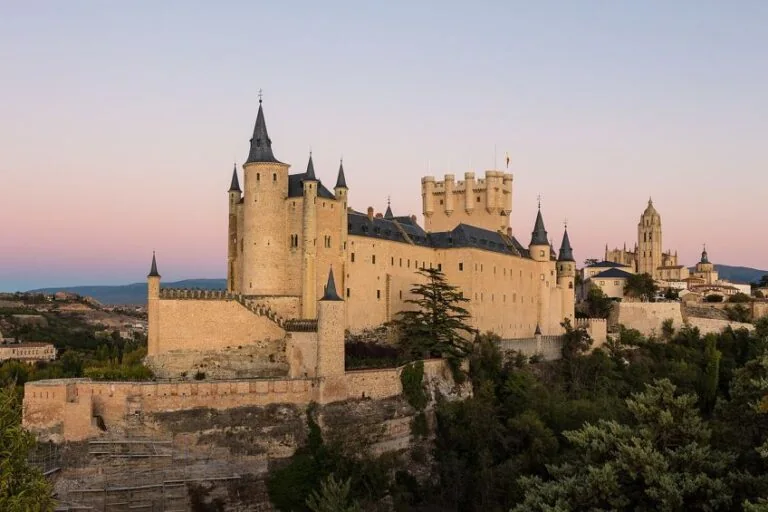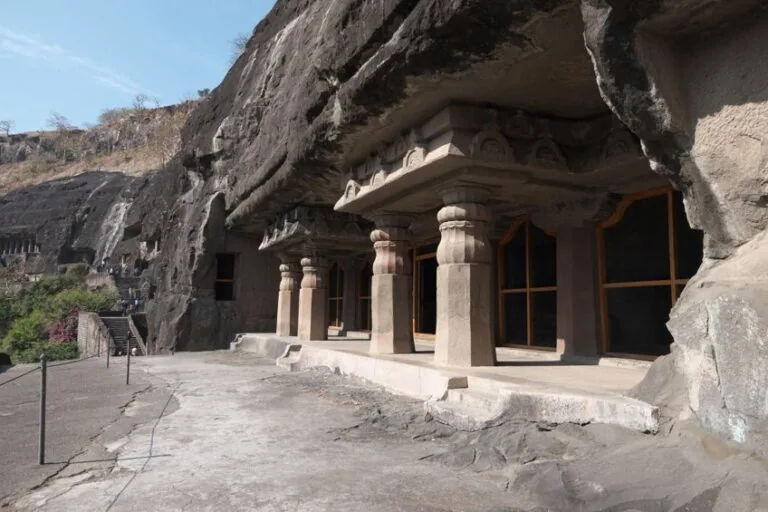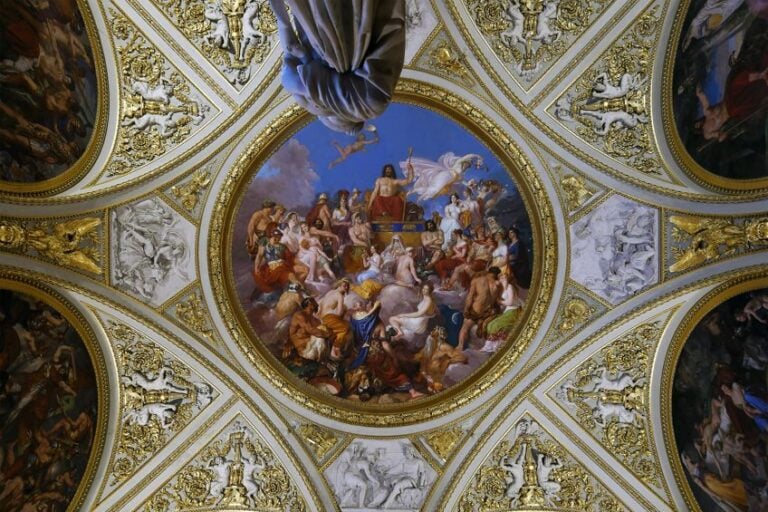Famous Castles – Ten Spectacular Fortresses You Have to See
When looking at castles, we often look at the most famous castles in Europe, but there are plenty of historical castles out there, from medieval castles and Samurai strongholds to Renaissance fortresses and Ottoman palaces. There are many a castle to visit in the wide world, and this article will show you ten such castles from across the globe. They are all old castles, but they’re not all too ancient. Some of them may even be somewhat recent, so read on to learn more about these castles, including the new and the old!
Contents
- 1 10 Castles Around the World Worth Visiting
- 1.1 Warwick Castle (1068 – 12th Century)
- 1.2 Malbork Castle (1274 – 1406)
- 1.3 Trakai Island Castle (Late 1300s – 1409)
- 1.4 The Forbidden City (1406 – 1420)
- 1.5 Topkapı Palace (1459 – 1465)
- 1.6 Matsumoto Castle (1590 – 1594)
- 1.7 Fasil Ghebbi (17th Century)
- 1.8 The Red Fort, or Lal Qila (1639 – 1648)
- 1.9 The Winter Palace (1730s – 1837)
- 1.10 Neuschwanstein Castle (1869 – 1886)
- 2 Frequently Asked Questions
10 Castles Around the World Worth Visiting
There are so many castles around the world and it can be very difficult to slip that down to only ten final contenders. These ten castles are castles from around the world. They are not all located within Europe and, in fact, most of them aren’t. So, have a look at the castles we’ve selected below and maybe you’ll find some new sights to see. Or maybe you’ll know them all. Who knows? Only one way to find out.
Warwick Castle (1068 – 12th Century)
| Architect | William the Conqueror |
| Date Constructed | 1068 (originally) |
| Modern Function | Entertainment venue |
| Location | Warwick, England |
Once upon a time, William the Conqueror marched into England in conquest and seized the throne. That act would lay the groundwork for the modern British monarchy, but it would also lay the groundwork for Warwick Castle. Proper medieval castles, made of wood, are hard to come by, and this one likely would not have lasted had it remained a wooden structure.
 Warwick Castle by Canaletto (1740’s); Canaletto, Public domain, via Wikimedia Commons
Warwick Castle by Canaletto (1740’s); Canaletto, Public domain, via Wikimedia Commons
Warwick Castle started its life as a wooden motte-and-bailey castle, but as wood is not the best material for surviving the ages, it was rebuilt in the 12th century but this time in stone. It’s a bit of a hardier substance than wood. That hardier nature would also allow the structure to serve as a stronghold until the 17th century. After that, King James I gave the old stronghold to Sir Fulke Greville. His family would become the Earls of Warwick.
 King James I of England and VI of Scotland by John De Critz the Elder (early 17th Century copy of a c. 1606 original); John de Critz, Public domain, via Wikimedia Commons
King James I of England and VI of Scotland by John De Critz the Elder (early 17th Century copy of a c. 1606 original); John de Critz, Public domain, via Wikimedia Commons
This castle may have had regal and aristocratic origins, but it was sold by the Greville family in 1978 to the Tussauds Group (now part of Merlin Entertainments). This means that Merlin Entertainments has control of one of the old castles of England, and you can go there whenever you want because if you’ve never heard of Merlin Entertainments, they put on quite a show.
Warwick Castle, a place once used as a stronghold, now allows for mock royal weddings, kid-friendly archery, and re-enactments of medieval festivities. It’s not a museum, as many old castles become, and is instead a castle to visit with the whole family. However, there are also some attractions of the less kid-friendly variety, such as the Mill & Engine House which allows patrons to see technology from the 14th century.
Malbork Castle (1274 – 1406)
| Architect | Unknown |
| Date Constructed | 1274 – 1406 |
| Modern Function | Museum and tourist attraction |
| Location | Malbork, Poland |
Along the banks of the Nogat River, Malbork Castle can be seen. This ancient castle has its origins in the Teutonic Order, a Germanic order of crusaders. This order of knights eventually lost the castle and it was sold to King Casimir IV, the king of Poland at the time. After that, it became the residence of several royals until it was taken by the Germans and held until 1945.
 Map of Teutonic States; Space Cadet and Offnfopt, CC BY-SA 3.0, via Wikimedia Commons
Map of Teutonic States; Space Cadet and Offnfopt, CC BY-SA 3.0, via Wikimedia Commons
This castle is a medieval fortress through and through. When it was completed, it was even considered to be the largest brick castle in the world. Much like many castles held by the Teutonic Order, it was designed with a Gothic style, and it was clearly once a valuable fortress. However, it lost its strategic value as military technology continued to develop. This led the structure to fall into disrepair.
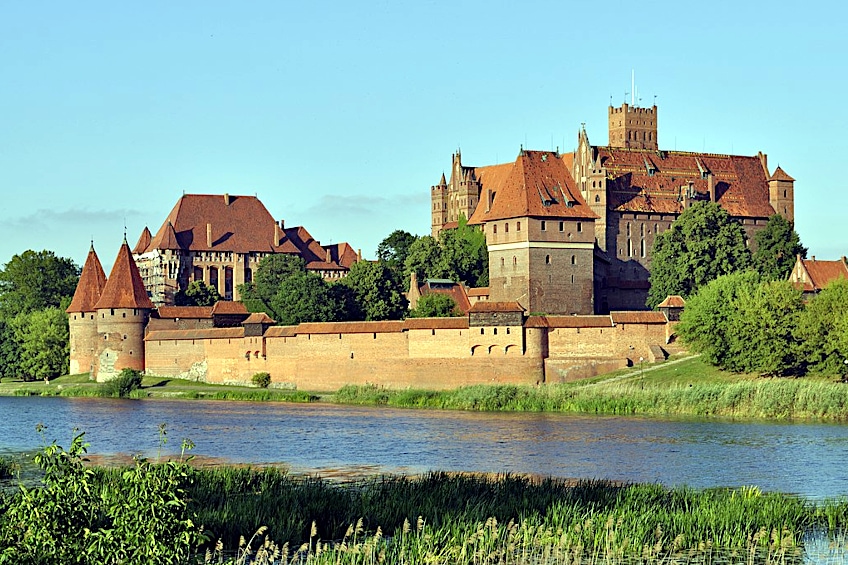 Malbork Castle; DerHexer; derivate work: Wladyslaw, CC BY 3.0, via Wikimedia Commons
Malbork Castle; DerHexer; derivate work: Wladyslaw, CC BY 3.0, via Wikimedia Commons
The castle was further significantly damaged during the Second World War, which must have been particularly annoying to those in charge of the structure because they’d just finished restoring it before the war, and so a new restoration project continued from 1962 all the way until April 2016.
Malbork Castle has since become a tourist destination complete with a museum and an amber exhibition. It may no longer be the largest brick castle in the world, but it is still the biggest brick structure in Europe. So, that’s just another reason to have a look at this large Teutonic-era castle.
Trakai Island Castle (Late 1300s – 1409)
| Architect | Kęstutis (1297 – 1382) and Vytautas (1350 – 1430) |
| Date Constructed | Late 1300s – 1409 |
| Modern Function | Tourist destination |
| Location | Trakai, Lithuania |
The Trakai Island Castle is a gorgeous castle situated right in the middle of a lake, Lake Galvė to be precise. Construction originally began under Kęstutis in the late 14th century, but he never finished the construction of this historical castle. Instead, his son completed the castle by 1409.
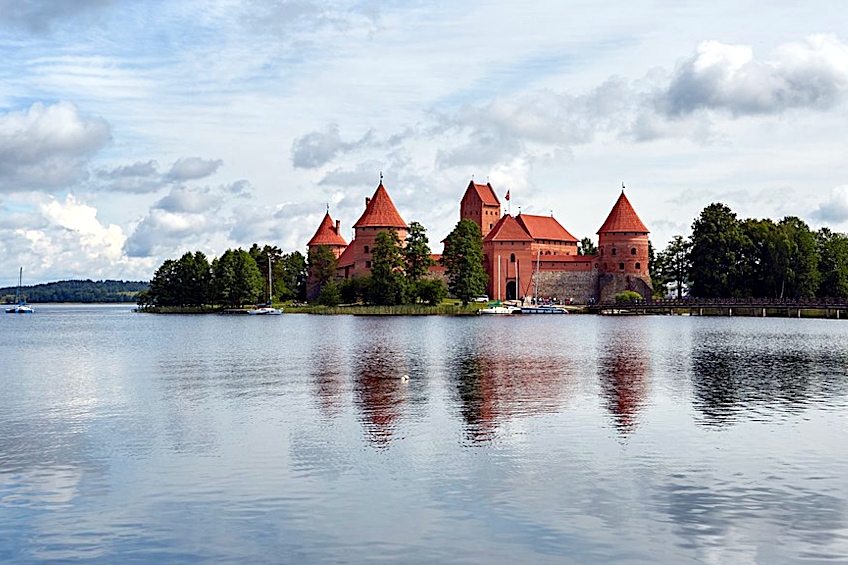 Trakai Island Castle; Vaido Otsar, CC BY-SA 4.0, via Wikimedia Commons
Trakai Island Castle; Vaido Otsar, CC BY-SA 4.0, via Wikimedia Commons
While this may be one of the grandest of medieval castles, it didn’t manage to survive unscathed throughout its existence. In 1377, before the castle was even entirely finished, it was subject to a devastating attack by the Teutonic Knights. This did not deter construction, and during a truce with said Knights, construction resumed.
During the second phase of construction, this famous castle added wings and a keep. After that, the castle was further reinforced and developed, but development stopped when the Grand Duchy of Lithuania, who controlled the castle, was defeated. This medieval castle then became a residence. It even served as a royal summer residence.
However, it was to fall entirely from grace. The castle was slowly turned into a prison as it fell into disuse and disrepair. The old castle may have fallen into complete ruin had it not been for the 19th-century reconstruction that aimed to preserve the original frescoes inside. Further restoration never managed to take off in any meaningful way until the 1940s. That restoration project would last from 1946 to 1961.
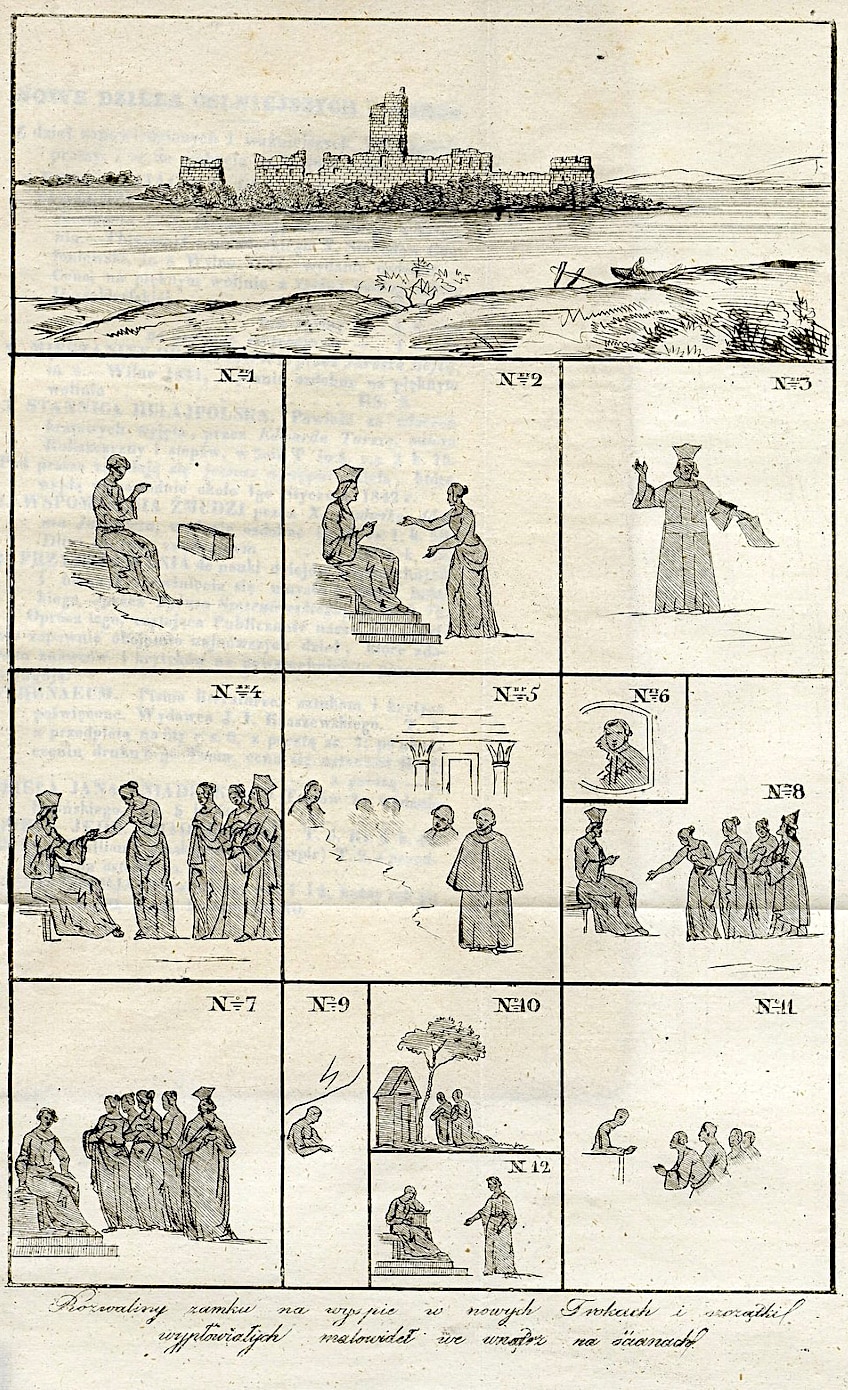 Watercolor paintings of the now-destroyed Frescoes of the Trakai Island Castle, depicting Vytautas the Great (1822); Vincentas Smakauskas (1797 – 1876), Public domain, via Wikimedia Commons
Watercolor paintings of the now-destroyed Frescoes of the Trakai Island Castle, depicting Vytautas the Great (1822); Vincentas Smakauskas (1797 – 1876), Public domain, via Wikimedia Commons
The castle has become a tourist attraction and it is a fantastic castle to visit. You can visit the Trakai Island Castle Museum or take in the gorgeous sights and sounds of Lake Galvė.
The Forbidden City (1406 – 1420)
| Architect | Kuai Xiang (1377 – 1451) |
| Date Constructed | 1406 – 1420 |
| Modern Function | Museum complex |
| Location | Beijing, China |
When historical castles were still in their heyday, as in, when they were used for their intended function, they were not usually a place just anyone could go. Many castles served as fortresses or imperial residences, but the Forbidden City was quite a different thing. This palace structure was intended to keep everyone out but the select few who were permitted entry. This extravagant complex was designed to keep the Chinese emperors separate from the world.
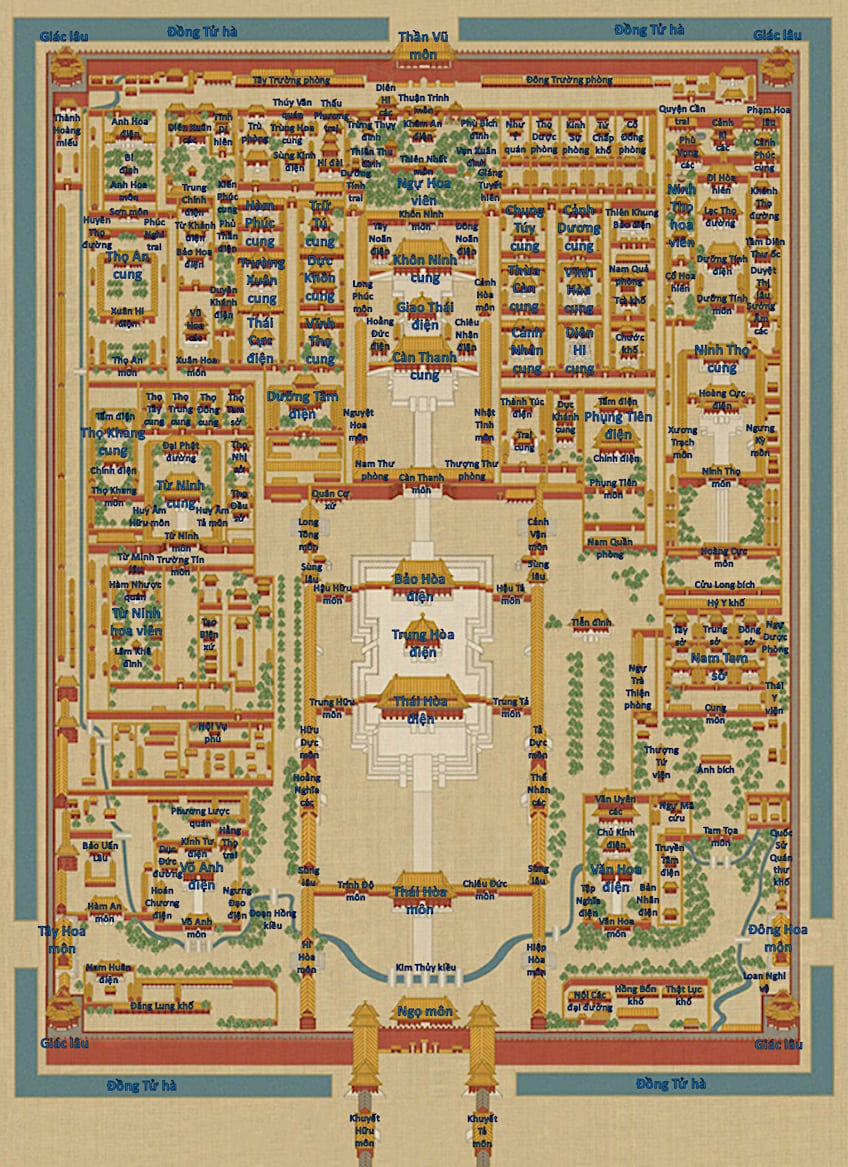 Plan of the main structures in the Forbidden City; Henry Pei, CC BY-SA 4.0, via Wikimedia Commons
Plan of the main structures in the Forbidden City; Henry Pei, CC BY-SA 4.0, via Wikimedia Commons
The Forbidden City itself was constructed under the order of Hongwu Emperor, the founding emperor of the Ming Dynasty, and it took fourteen years to construct. The vast complex required over a million workers, and it was built using large blocks of marble, Phoebe zhennan wood, and the floors were paved in seemingly golden bricks. It was a lavish palace for the newly established Ming Dynasty and it would remain under their control from 1420 to 1644.
The golden pagodas are indicative of traditional Chinese architecture and the red structures that populate the walls of the Forbidden City constitute the largest collection of preserved wooden structures in the world. It has been maintained and preserved to this day as a museum operated under the control of the Palace Museum.
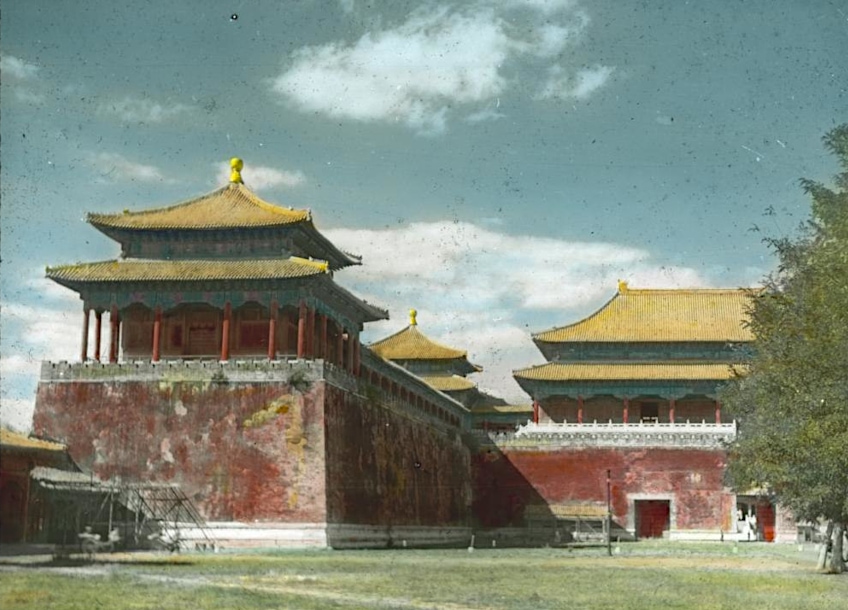 Hand painted lantern slide of the Meridian Gate of the Forbidden City; Powerhouse Museum from Sydney, Australia, Public domain, via Wikimedia Commons
Hand painted lantern slide of the Meridian Gate of the Forbidden City; Powerhouse Museum from Sydney, Australia, Public domain, via Wikimedia Commons
The museum itself has been in operation since 1925, shortly after the fall of the final Chinese emperor. The museum itself holds a gigantic collection of artworks and artifacts. These treasures are a combination of newer additions and some that date back to the Ming and Qing Dynasties. This is one of the most historic castles that one can visit, and its massive collection of museum artifacts should be worth the trip on its own.
Topkapı Palace (1459 – 1465)
| Architect | Mehmed II (1432 – 1481), Mimar Sinan (1488 – 1588), Davud Ağa (1598 – Unknown) and Sarkis Balyan (1835 – 1899) |
| Date Constructed | 1459 – 1465 |
| Modern Function | Museum |
| Location | Istanbul, Turkey |
Topkapı Palace was the primary residence of the sultans during their reign over the Ottoman Empire. This famous castle stood as the administrative center of that empire, and it started its existence under the order of Sultan Mehmed the Conqueror after the Ottoman takeover of Constantinople (or modern-day Istanbul). Construction officially began in 1459 and was completed in 1465, but because of a major earthquake in 1509 and a fire in 1665, it has been rebuilt in some sense or another several times over the course of its existence.
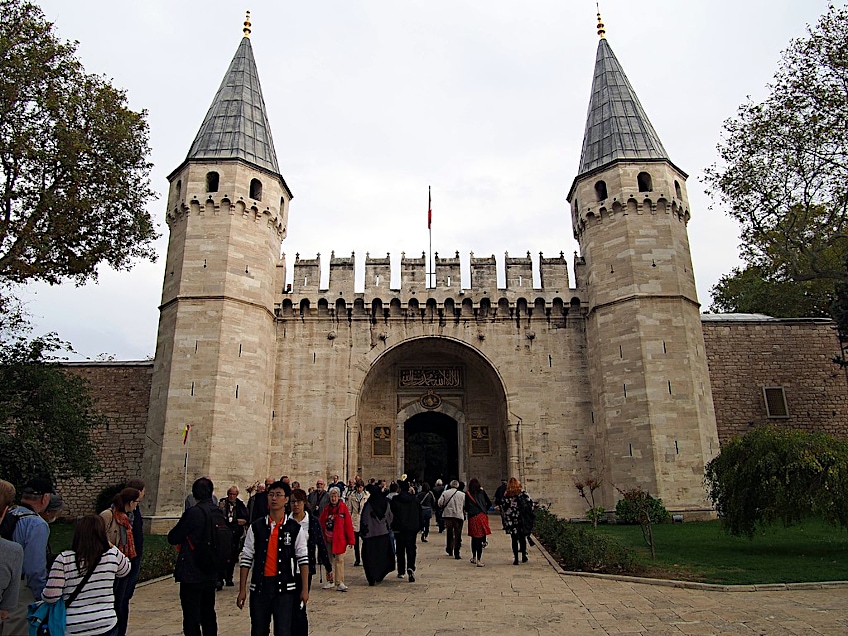 Topkapı Palace entrance gate; rheins, CC BY 3.0, via Wikimedia Commons
Topkapı Palace entrance gate; rheins, CC BY 3.0, via Wikimedia Commons
The Topkapı Palace was constructed in an Ottoman Baroque style, but there may have been some Byzantine influence in some aspects of the building as there are towers in one of the courtyards that betray a difference in architectural design. However, over the course of its long existence, the castle gained multiple additions and various architects from various eras had their say over some of the changes that were implemented.
As the residence of the sultans, Topkapı Palace was a royal residence, and it served its function for over 400 years. Since the 17th century, many of the sultans spent less time at this historical castle and instead set up new palaces, but this particular structure was always maintained as it served several functions, such as serving as the imperial library.
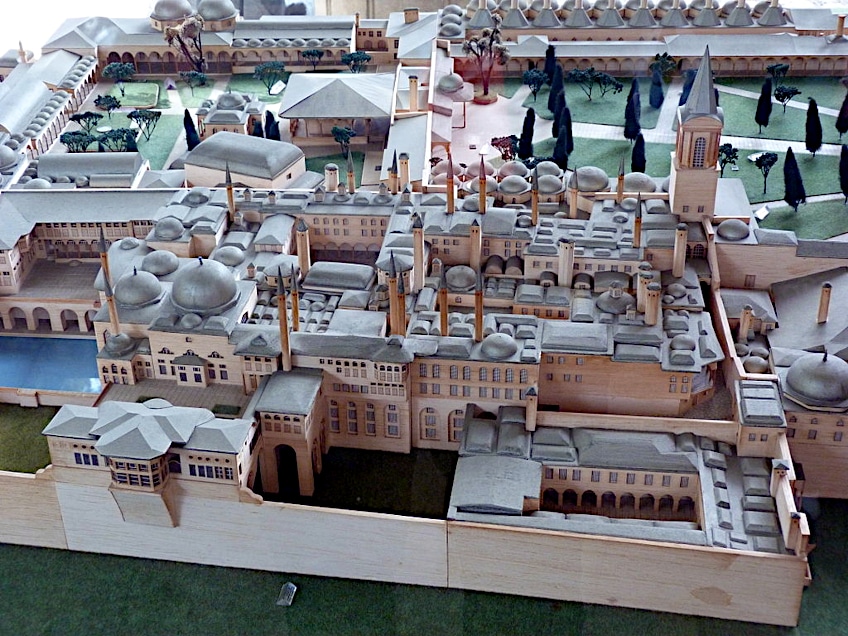 Architectural model showing part of the Topkapi Palace; Derzsi Elekes Andor, CC BY-SA 4.0, via Wikimedia Commons
Architectural model showing part of the Topkapi Palace; Derzsi Elekes Andor, CC BY-SA 4.0, via Wikimedia Commons
The Topkapı Palace did not remain a royal symbol and residence forever. As time progressed, the Ottoman Empire entered the First World War on what would become the losing side. This led to the Ottoman monarchy falling away. The Topkapı Palace, once the Ottomans had fallen, was turned into a museum by government decree. You can visit it for that purpose to this day.
Matsumoto Castle (1590 – 1594)
| Architect | Shimadachi Sadanaga (16th century) |
| Date Constructed | 1590 – 1594 |
| Modern Function | Tourist destination |
| Location | Matsumoto, Japan |
There are few remnants still standing of the old Shogunate time in Japan when the country was ruled by various warlords who used the divine emperor as little more than a political pawn. This time period was also a time of unification, and one of the major forces for this enforced unification was the Tokugawa shogunate. This particular military dictatorship is better known under a much friendlier-sounding name: the Edo Period.
 Ukiyo-e woodbock print of Shogun Tokugawa Ieyasu from Mikawa Eiyu Den (published in 1873); Utagawa Yoshitora, Public domain, via Wikimedia Commons
Ukiyo-e woodbock print of Shogun Tokugawa Ieyasu from Mikawa Eiyu Den (published in 1873); Utagawa Yoshitora, Public domain, via Wikimedia Commons
The Edo Period saw various domains being instituted and one of them was the Matsumoto Domain. This domain used the Matsumoto Castle which was already in some level of use. The original structure dates back to 1504, but the castle itself was only developed into what it is now nearly a century later. It is a flatland castle that would have adopted a variety of defensive mechanisms during its intended use.
The structure itself is made of wooden interiors with an exterior constructed from stone. The structure is also known as the Crow Castle. It has received this ominous title because the walls are painted black, and the roofs are painted to match them. It is considered to be one of the great Japanese castles, along with other famous castles like Himeji and Kumamoto Castle. In addition, the Matsumoto Castle has been declared an official National Treasure of Japan. This signifies that it has particular value to the cultural history of Japan.
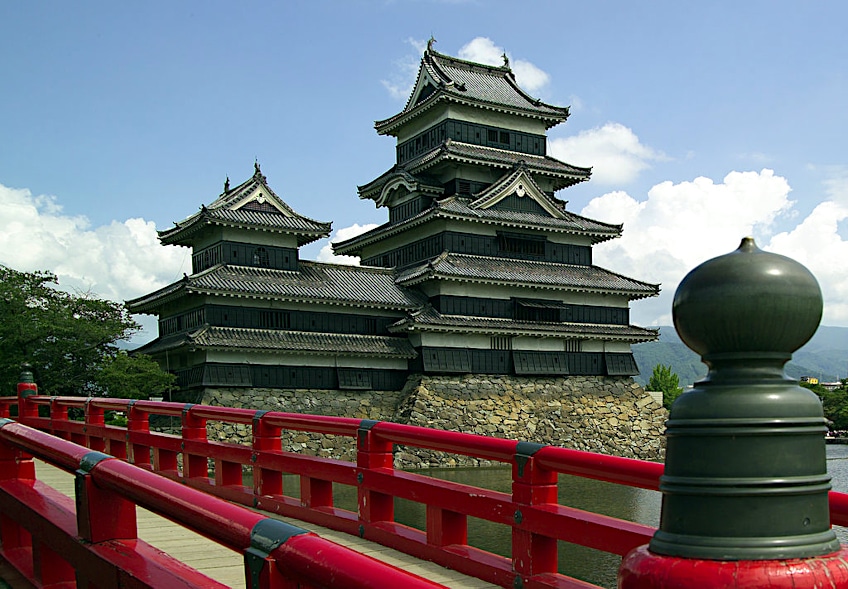 Matsumoto Castle; Fg2, Public domain, via Wikimedia Commons
Matsumoto Castle; Fg2, Public domain, via Wikimedia Commons
The Matsumoto Castle was nearly destroyed during the Meiji Period. That period of time, in which the emperor was restored to a place of political authority, saw the destruction of many shogun-era castles and monuments. However, the people of Matsumoto, the nearby city, appealed to the government to stop their plans to destroy the now-iconic castle. The castle was ultimately given to the city and it has since been preserved and is open to the public.
Fasil Ghebbi (17th Century)
| Architect | Emperor Fasilides (1603 – 1667) |
| Date Constructed | 17th century |
| Modern Function | Tourist attraction |
| Location | Gondar, Ethiopia |
Ethiopia has an ancient civilization that does not tend to receive as much attention as it likely should, and the Fasil Ghebbi is a testament to that ancient civilization. This may not be one of the most famous castles around the world to many in the west, but it very likely should be considered as such. This castle marked the beginning of a new era in Ethiopian history and the monarchy of the country.
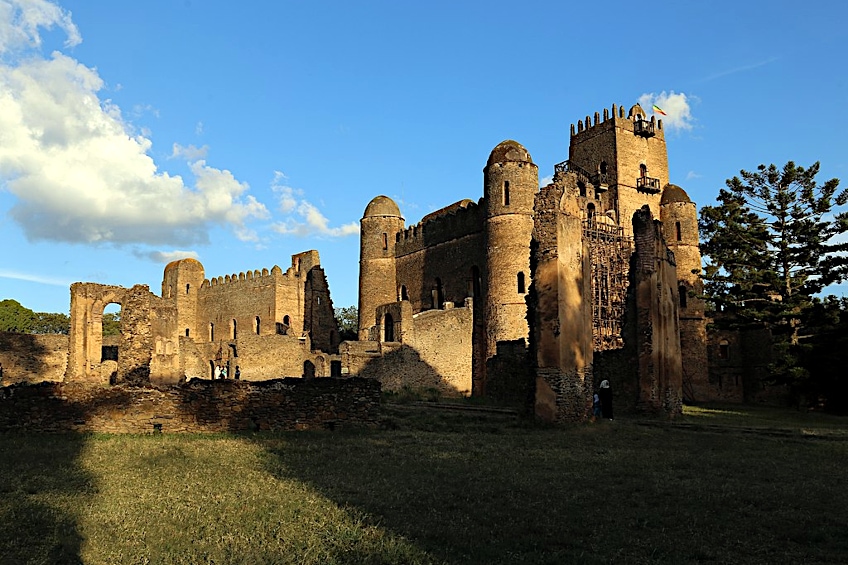 Fasil Ghebbi Castle; Sailko, CC BY 3.0, via Wikimedia Commons
Fasil Ghebbi Castle; Sailko, CC BY 3.0, via Wikimedia Commons
This fortress was built under the order of Emperor Fasilides in the 17th century, and it signaled a major change in the way things were done. Before the construction of this new castle home, the emperors of Ethiopia lived largely nomadic lives as they moved from one village to the next and effectively lived off the produce of the people. In addition, they lived wherever they went, and so often dwelt in tents, but with the creation of this historical castle, the emperors finally had a place to lay down royal roots.
Originally, Fasil Ghebbi was relatively modest and contained architectural design reminiscent of various sources, such as Indian, Nubian, and Arab influences. However, the later additions adopted a more baroque style. Those later additions came about because Emperor Fasilides’s grandson, Emperor Iyasu the Great, expanded on the design and turned the structure into an extravagant palace. The extravagance extended to aspects such as gem-inlaid ceilings and masses of ivory sculptures that now adorn the monument to the ancient Ethiopian monarchy.
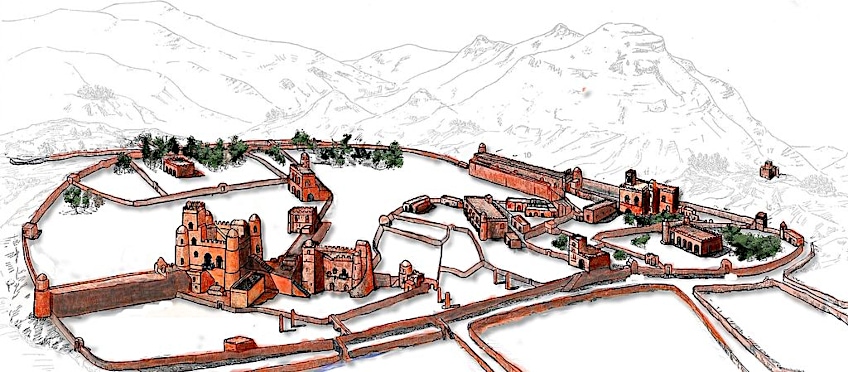 Schematic showing the layout of Fasil Ghebbi; Hgetnet, CC0, via Wikimedia Commons
Schematic showing the layout of Fasil Ghebbi; Hgetnet, CC0, via Wikimedia Commons
The original structure did not fare well throughout history as it suffered from attacks by foreign invaders, earthquakes, and even British bombing raids. However, it was declared a UNESCO World Heritage Site in 1979 and has since been restored to a much better condition. In addition, the castle can be visited as a tourist attraction, and it is highly recommended that you get a tour guide because the various structures within the compound require a lot of historical context.
The Red Fort, or Lal Qila (1639 – 1648)
| Architect | Ustad Ahmad Lahori (1580 – 1649) |
| Date Constructed | 1639 – 1648 |
| Modern Function | Tourist attraction and historical site |
| Location | Delhi, India |
Lal Qila, or the “Red Fort,” is a historical castle that once acted as the main residence of various leaders of India. It was originally constructed under the order of Emperor Shah Jahan, who was the Mughal Emperor at the time. The fort has become a symbol of the Indian people in the centuries since its initial construction and has served various functions since then.
The Red Fort was first built as a royal residence. It was solely intended for the Mughal Emperors. It was built in Old Delhi, which can be found in modern-day Delhi, and it was built between 1639 and 1648. It adopted a combination of Indian traditional architecture with Persian architecture and the inner chambers expressed a mix of Mughal, Persian, Timurid, and Hindu designs. However, the majesty it once contained is, sadly largely gone.
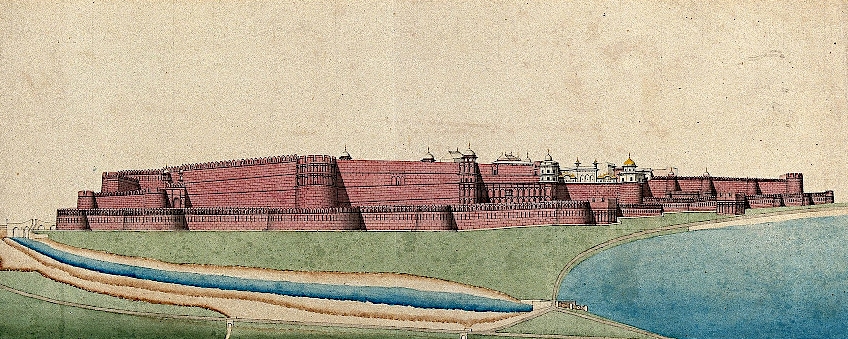 Painting of the Red Fort by an unknown Indian painter (between 1800 and 1899); See page for author, CC BY 4.0, via Wikimedia Commons
Painting of the Red Fort by an unknown Indian painter (between 1800 and 1899); See page for author, CC BY 4.0, via Wikimedia Commons
In 1857, during the Indian Rebellion, this Mughal palace was ransacked and the emperor was forced from power. Many of the artifacts and artworks on display in the Red Fort were stolen. However, the Red Fort, as a strong fortress, was eventually used as a garrison and later became a symbol of Indian independence and unity.
When India achieved its independence on 15 August 1947, Jawaharlal Nehru, the first democratically elected prime minister of India, gave a speech from the ramparts. He raised the new Indian flag and declared independence. This tradition is continued to this day. Every 15 August, the flag is raised, and the prime minister speaks to the people of India in a national address.
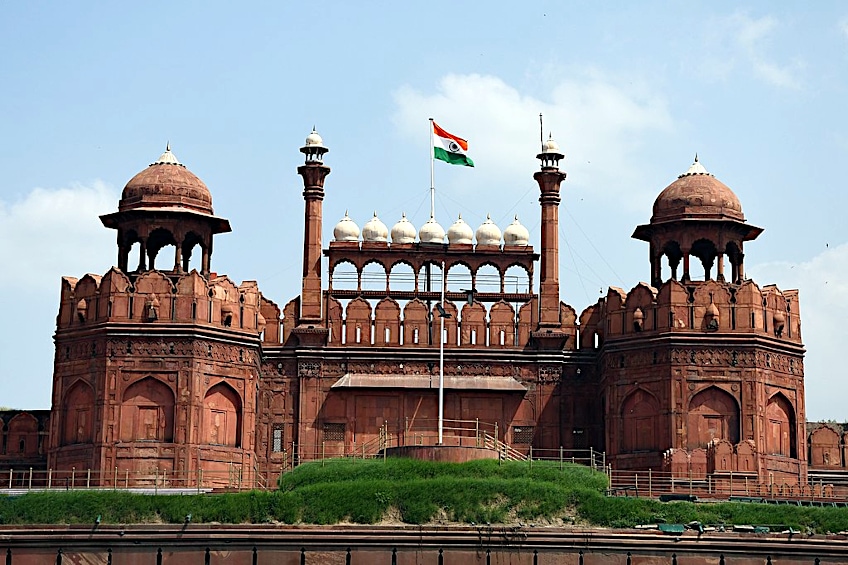 The Indian flag flying between domes at the Red Fort; Amantambulkar, CC BY-SA 4.0, via Wikimedia Commons
The Indian flag flying between domes at the Red Fort; Amantambulkar, CC BY-SA 4.0, via Wikimedia Commons
An interesting final note is that the Red Fort was not the only thing commissioned by Emperor Shah Jahan. He was also the one who commissioned the construction of India’s most famous architectural marvel and a symbol of India itself: the Taj Mahal. This famed Mughal Emperor was responsible for many of the great architectural triumphs of the Mughal Empire.
The Winter Palace (1730s – 1837)
| Architect | Francesco Bartolomeo Rastrelli (1700 – 1771) |
| Date Constructed | 1730s – 1837 |
| Modern Function | Art museum |
| Location | St. Petersburg, Russia |
Few places have the infamous privilege of being part of a major revolution. The Winter Palace or Hermitage is one such place. This decadent symbol of the Romanov Family’s rule in Russia was one of many contributory factors to the October Revolution that led to the communist takeover of Russia and the eventual creation of the USSR. This eventual fate would be one of the most important in the history of the 20th century.
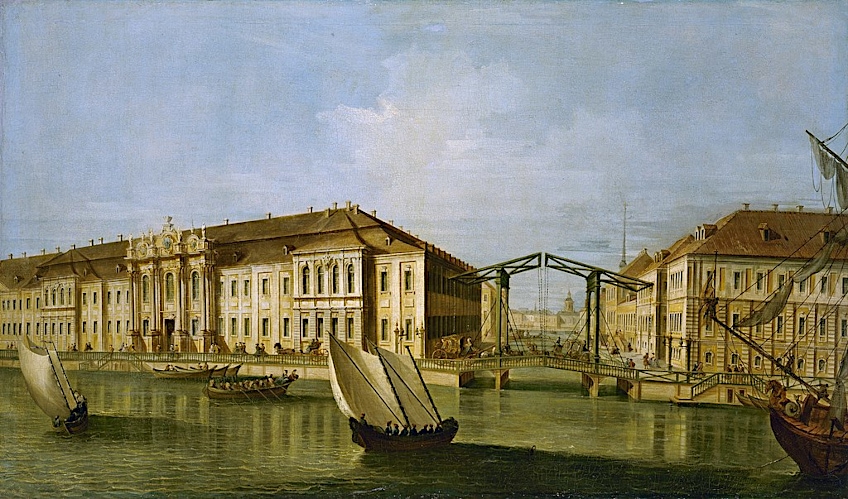 View of the Winter Palace by an unknown Italian artist after a drawing by Mikhail Makhaev (1750); Hermitage Museum, Public domain, via Wikimedia Commons
View of the Winter Palace by an unknown Italian artist after a drawing by Mikhail Makhaev (1750); Hermitage Museum, Public domain, via Wikimedia Commons
The Winter Palace was built between the late 1730s and 1837. It was constantly developed, and additions were made and altered throughout that roughly one-hundred-year period. It was a luxurious castle that adopted a baroque architectural style as the outside of the majestic structure was painted green and white. The interior of this massive palace was beset with pink marble Corinthian columns and the floors were cast in patterned parquet flooring. The Winter Palace housed many Czars and Czarinas over its long lifetime, such as Catherine the Great and, lastly, Nicholas II.
The only reason the construction was halted in 1837 was because of a terrible fire that destroyed much of the palace. This fire did not truly halt anything though as construction immediately resumed. However, the Winter Palace was ultimately stormed by revolutionaries in 1917 and Nicholas II was forced to abdicate from the throne, thus ending the Romanov line. His fate would ultimately be a grim one in the history of the world.
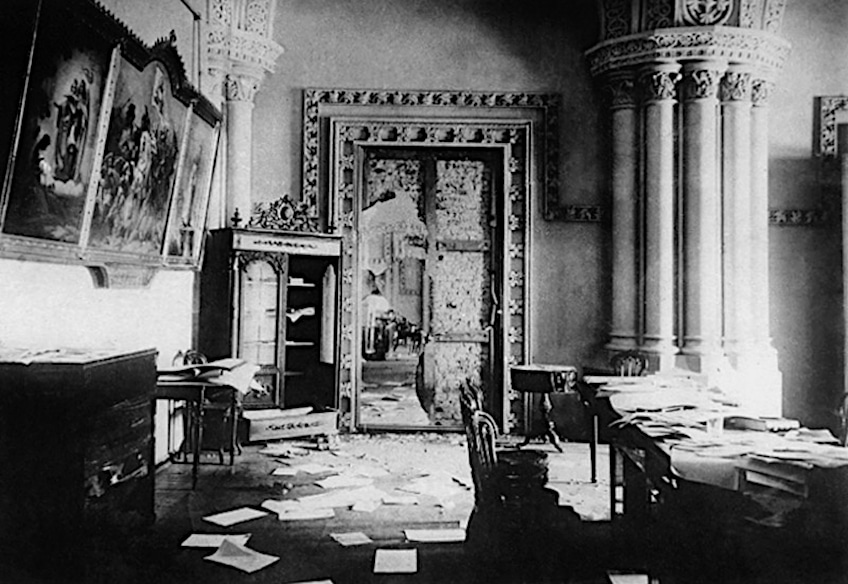 The Gothic Hall of the Winter Palace after the seizure by squads of the Military Revolutionary Committee of the Soviet of Workers ‘and Soldiers’ Deputies (1917); Yakov Vladimirovich Steinberg, Public domain, via Wikimedia Commons
The Gothic Hall of the Winter Palace after the seizure by squads of the Military Revolutionary Committee of the Soviet of Workers ‘and Soldiers’ Deputies (1917); Yakov Vladimirovich Steinberg, Public domain, via Wikimedia Commons
In the aftermath of the Revolution, the Winter Palace became the center of the Provisional Government that would eventually fall to the Bolsheviks. However, this once-great site has since become the second-largest art gallery in terms of pure space and houses many notable pieces by celebrated artists. The State Hermitage Museum contains pieces from artists such as Leonard da Vinci, Alonso Cano, Goya, and many others.
So, if you’re looking for a place to visit that is second only to the Louvre in Paris in terms of gallery space, then this is the place to visit. In fact, the State Hermitage Museum existed before the Romanovs were forced from the Winter Palace, and that means that this museum is actually about 30 years older than the Louvre.
Neuschwanstein Castle (1869 – 1886)
| Architect | Eduard Riedel (1813 – 1885) |
| Date Constructed | 1869 – 1886 |
| Modern Function | Guided tour destination |
| Location | Schwangau, Germany |
We’re going to end off with one of the most famous castles in the world. The fairy tale castle itself, Neuschwanstein Castle. This is probably one of the most famous castles in the world and an absolute necessity for anyone interested in castles of any description. It is a gorgeous and magical structure that makes use of various pinnacles and towers that lend the whole thing a truly whimsical air about it. It reflects a 19th century romanticism that saw a building boom based on the transformation of gloomy medieval and baroque castles into fantasy gothic-inspired palaces.
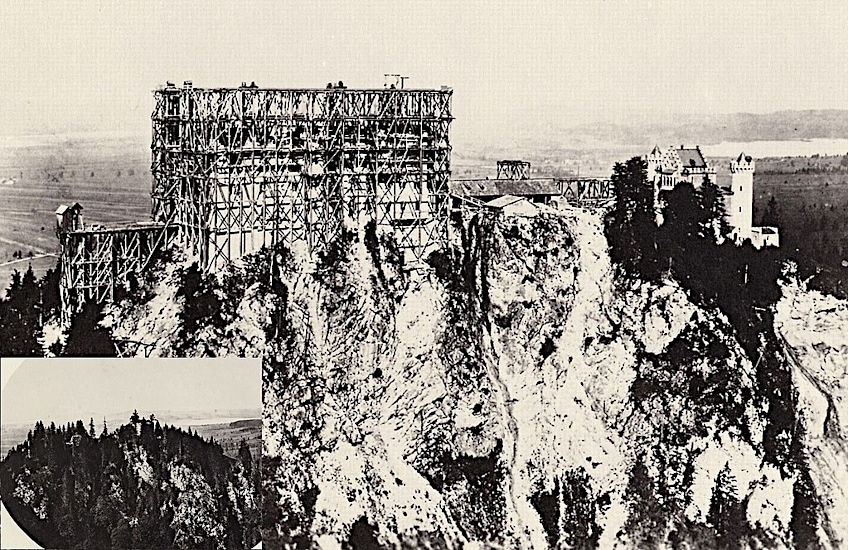 Neuschwanstein construction site in 1875 and inset image of the site prior to construction in 1860; zeitgenössische Fotografen 1860 bzw. 1875, Public domain, via Wikimedia Commons
Neuschwanstein construction site in 1875 and inset image of the site prior to construction in 1860; zeitgenössische Fotografen 1860 bzw. 1875, Public domain, via Wikimedia Commons
Red bricks cover the exterior and the court fronts are decorated in limestone. The interior was meant to be comprised of 200 rooms, but the castle was never completed. However, the rooms that were completed are ornate pieces of art in their own right and covered in tapestries, murals, and various pieces of art that depict numerous legends and fairy tales.
The castle itself was commissioned by King Ludwig II in 1868. There had been political upheaval in the country, and he’d been stripped of his political power, so Neuschwanstein Castle was meant to be a new home. However, he never survived to see the castle finished. Although he may have been happy to know that the castle, as it stands today, has become one of the most popular tourist destinations in Europe.
![]() Iconic Photochrom print of Neuschwanstein Castle taken in the first decade following the completion of the castle; See page for author, Public domain, via Wikimedia Commons
Iconic Photochrom print of Neuschwanstein Castle taken in the first decade following the completion of the castle; See page for author, Public domain, via Wikimedia Commons
Everyone wants to have a look at this international symbol of Romanticism and sometimes there are as many as 6,000 people a day at the castle. Neuschwanstein Castle has become a tourist destination that absolutely everyone interested in castles wants to see. It makes sense too. Wouldn’t you want to see it too?
Thus concludes our list of ten castles around the world. There are many that are worth visiting, but these are the ones we’ve focused on today. Some of these are extremely old castles, but some of them are relatively younger. They are also from all around the world and are not simply concentrated in Europe, because there are also castles in Africa, Asia, and Europe. They’re all over the world and they’re all worth a look, but, for now, maybe stick to ten. Don’t want to overload yourself, do you?
Frequently Asked Questions
What Is the Oldest Castle Here?
Warwick Castle in England is an old castle. It’s one of the oldest medieval castles in England, and the original structure was a wooden fort. So, it may seem a little unfair as it only acquired stone sections much later, but this famous castle was technically first constructed in 1068. It truly is an ancient castle.
What Is the Youngest Castle Here?
Neuschwanstein Castle in Germany is the youngest castle here. Many of these castles are extremely old castles, and some are even dated to the medieval period and beyond. However, the Neuschwanstein Castle was completed in the late 19th century, so it’s less than 150 years old.
What Is the Most Famous Castle Here?
Neuschwanstein Castle in Germany is likely the most famous castle on this list. Measuring the most famous version of anything is often subjective, but the fairy-tale, picturesque image of this castle created by a man who believed in fairies tends to top many lists of the most famous castles around the world. This castle was also the inspiration for Sleeping Beauty’s castle in the Disney animation of the same name.

I am deeply passionate about history and am constantly fascinated by the rich and complex stories of the past. As the editor-in-chief of learning-history.com, I have the opportunity to share this passion with a wide audience through the creation and distribution of engaging and informative content about historical events, persons, and cultures. Whether it’s through writing articles and blog posts or creating videos or podcasts, I strive to bring the past to life in a way that is both accurate and enjoyable. My expertise in history, combined with my strong writing and communication skills, allows me to effectively communicate complex historical concepts and make them accessible and interesting to a wide range of readers. I am truly grateful for the opportunity to share my love of history with others through my work on learning-history.com.

